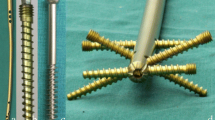Abstract
The aim of this study is to evaluate interlocking intramedullary nails in the treatment of fractures. We retrospectively reviewed 68 adult patients (for a total of 95 fractures) with isolated long-bone fractures who were treated with interlocking intramedullary nails between January 2010 and January 2012. The patients were followed for 18 months to observe the healing of the fracture, time, and the occurrence of complications in the shoulder, knee, and hip joint functions. After about a follow-up period of 26.2 months (range 18–39 months), all cases obtained bony union. The mean time to fracture union was 5.2 months. Cases of knees and hip joint functions of the femoral or tibial fracture and shoulder functions of the humeral fractures were observed. The interlocking intramedullary nails may be considered as an alternative method for isolated diaphyseal fractures of the extremities. The advantages of this method include small operative scars, reliable fixations, better fracture healings, and fewer complications.




Similar content being viewed by others
References
Ouyang, X., Wang, J., Wang, P., et al. (2006). Treatment of the floating knee with interlocking intramedullary nail and limited open reduction. Journal of Practical Orthopedics, 12, 9–12.
Sun, L., Liu, X., Wang, X., et al. (2005). The treatment of extremity fractures using the interlocking nail. Chinese Journal of Orthopedics, 25, 129–135.
Li, H., Yao, S., Zhao, C., et al. (2005). The study of reamed versus unreamed femoral intramedullary nailing for femoral shaft fracture. Chinese Journal of Bone and Joint Injury, 20, 104–106.
Wang, J., Yu, G., Wang, S., et al. (2004). Cause analysis and handling of the postoperative complications of the tubular bone fractures of lower extremities treated with intramedullary interlocking nails. Chinese Journal of Bone and Joint Injury, 19, 164–166.
Zhang, T., Pang, G., Wang, J., et al. (2005). Complication prevention in the treatment of femoral shaft fracture with interlocking intramedullary nail. Chinese Journal of Bone and Joint Injury, 20, 289–291.
Reid, J. S. (2003). Fractures of the proximal humerus. Current Opinion in Orthopaedics, 14, 269–280.
Visser, C. P., Coene, L. N., Brand, R., et al. (2001). Nerve lesions in proximal humeral fractures. Shoulder Elbow Surgery, 10, 421–427.
Neer, C. S. (1955). Articular replacement for the humeral head. Bone Joint Surgery (Am), 37, 215–228.
Demirhan, M., Kilicoglu, O., Ahinel, L., et al. (2003). Prognostic factors in prosthetic replacement for acute proximal humerus fractures. Journal of Orthopaedics Trauma, 17, 181–188.
Neer, C. S. (1970). Displaced proximal humera1 fractures treatment of three-part and four-part displacement. Journal Bone Joint Surgery (Am), 52, 1090–1103.
Boileau, P., Trojani, C., & Walch, G. (2001). Shoulder arthroplasty for the treatment of the secuelae of fractures of the proxi mal humerus. Shoulder Elbow Surgery, 10(4), 299.
Urner, N. M., Van de Leemput, A. J., Draaisma, J., et al. (2008). Validity of the visual analogue scale as an instrument to measure self-efficacy in resuscitation skills. Medical Education, 42(5), 503.
Vallier, H. A., Cureton, B., Patterson, A., & Brendan, M. (2012). Factors influencing functional outcomes after distal tibia shaft fractures. Journal of Orthopaedic Trauma, 26(3), 178–183.
Kitaoka, H. B., Alexander, I. J., Adelaar, R., et al. (1994). Clinical systems for the ankle-hindfoot, midfoot, hallux and lesser toes. Foot Ankle, 15(7), 349–353.
Zhang, Z. (2005). 24 cases analysis of distal tibial 1/3 fracture with Locking intramedullary nail in treatment. Journal of Ningxia Medical College, 27(4), 317–318.
Leliveld, M. S., & Verhofstad, M. H. (2012). Injury to the infrapatellar branch of the saphenous nerve a possible cause for anterior knee pain after tibial nailing. Injury, 43(6), 779–783.
Wang, Y., Tang, P., Cai, X., et al. (2009). Campbell’s Operative Orthopaedics (10th ed., pp. 2557–2559). Beijing: People’s Medical Publishing House.
Werner, A., Bohm, D., Ilg, A., et al. (2002). KaPandji intramedullary wire osteosynthesis in proximal humeral fractures. Un fallehirurg, 105(4), 332–337.
Otoole, R. V., Gobezie, R., Hwang, R., et al. (2006). Low complication rate of LISS for femur fractures adjacent to stable hip or hip arthroplasty. Clinical Orthopaedics, 450, 203–210.
Ito, K., Hungerbuhler, R., Wahl, D., et al. (2001). Improvedin-tramedullary nail interlocking in osteoporotic bone. Jounal of Orthopaedic Trauma, 3, 192–196.
Haentjens, P., Casteleyn, P. P., DeBoek, H., et al. (1989). Treatment of unstable intertrochanteric and subtrochanteric fractures in elderly patients. Primary bipolar arthroplasty compared with internal fixation. Bone Joint Surgery, 71, 1214–1225.
Author information
Authors and Affiliations
Corresponding author
Rights and permissions
About this article
Cite this article
Ouyang, X., Wang, J.R., Hong, S.D. et al. Interlocking Intramedullary Nails in Fracture Treatment. Cell Biochem Biophys 73, 261–265 (2015). https://doi.org/10.1007/s12013-015-0622-8
Published:
Issue Date:
DOI: https://doi.org/10.1007/s12013-015-0622-8




